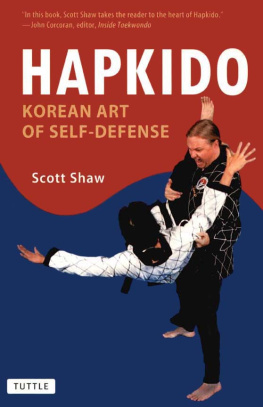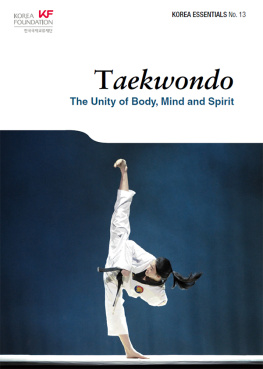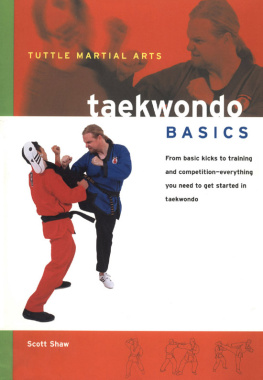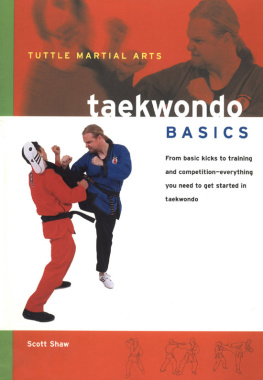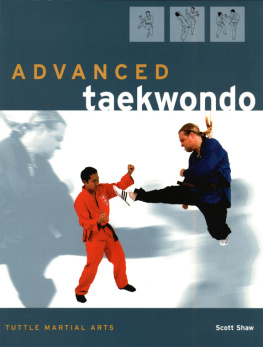Disclaimer: Please note that the publisher and authors of this instructional book are NOT RESPONSIBLE in any manner whatsoever for any injury that may result from practicing the techniques and/or following the instructions given within. Martial arts training can be dangerousboth to you and to othersif not practiced safely. If youre in doubt as to how to proceed or whether your practice is safe, consult with a trained martial arts teacher before beginning. Since the physical activities described herein may be too strenuous in nature for some readers, it is also essential that a physician be consulted prior to training.
Published by Tuttle Publishing, an imprint of Periplus Editions (HK) Ltd., with editorial offices at 364 Innovation Drive, North Clarendon, Vermont 05759 U.S.A.
Copyright 2009 Dr. Tony Kemerly and Steve Snyder
All rights reserved. No part of this publication may be reproduced or utilized in any form or by any means, electronic or mechanical, including photocopying, recording, or by any information storage and retrieval system, without prior written permission from the publisher.
Library of Congress Cataloging-in-Publication Data
Kemerly, Tony.
Taekwondo grappling techniques : hone your competitive edge for mixed martial arts/Tony Kemerly, Steve Snyder.
p. cm.
ISBN 978-0-8048-4006-4 (pbk.); ISBN: 978-1-4629-0991-9 (ebook)
1. Tae kwon do. 2. Hand-to-hand fighting, Oriental. 3. Mixed martial arts. I. Snyder, Steve. II. Title.
GV1114.9.K46 2009
796.8153--dc22
2008053309
DISTRIBUTED BY
North America, Latin America & Europe
Tuttle Publishing
364 Innovation Drive
North Clarendon, VT 05759-9436 U.S.A.
Tel: 1 (802) 773-8930; Fax: 1 (802) 773-6993
www.tuttlepublishing.com
Japan
Tuttle Publishing
Yaekari Building, 3rd Floor
5-4-12 Osaki, Shinagawa-ku
Tokyo 141 0032
Tel: (81) 3 5437-0171; Fax: (81) 3 5437-0755
Asia Pacific
Berkeley Books Pte. Ltd.
61 Tai Seng Avenue #02-12
Singapore 534167
Tel: (65) 6280-1330; Fax: (65) 6280-6290
www.periplus.com
First edition
13 12 11 10 09 5 4 3 2 1
Printed in Singapore
TUTTLE PUBLISHING is a registered trademark of Tuttle Publishing, a division of Periplus Editions (HK) Ltd.
ACKNOWLEDGMENTS
I would like to thank my wife Trish for all of her photography skills (free of charge), time, and heartfelt enthusiasm for this project. Without her, this project would not have gotten off of the ground. Dr. Tony Kemerly
I would like to thank my close friends Trish and Tony Doc Kemerly for all their continued support over the years; LDMA dedicated students who make teaching martial arts exciting every day; Mr. Danny Dring for always being a good friend, coach, and motivating me to reach higher levels in martial arts; Most of all, to my wife, Mariea, and children, Deven and Elizabeth, for supporting me and making everything in life complete. Steve Snyder
DEDICATION
We dedicate this book to all of our students and fellow martial artists in their continued pursuit of excellence in the martial arts.
I would like to dedicate this book to Mr. Danny Dring, Mr. Berl Parsons, Mr. Joe Lewis, Mr. Bill Superfoot Wallace, Mr. Allen Branch, Mr. Rick Hoadley, and Mrs. Mariea Snyder; you are my heroes. I have great appreciation for everything you have done to influence and expand my knowledge in martial arts. Steve Snyder
CONTENTS
CHAPTER 1
CHAPTER 2
CHAPTER 3
CHAPTER 4
CHAPTER 5
CHAPTER 6
CHAPTER 7
CHAPTER 8
CHAPTER 9
CHAPTER 10
CHAPTER 11
CHAPTER 12
CHAPTER 13
CHAPTER 14
CHAPTER 15

How to Download the Bonus Material of this Book.
1. You must have an internet connection.
2. Click the link below or copy paste the URL to your web browser.
http://www.tuttlepublishing.com/taekwondo-grappling-techniques-downloadable-cd-content
For support email us at .
Contents
- Video Files (.mp4)
Disclaimer:
"Please check the audio and video specifications of your ebook reader before downloading any additional content."


Taekwondos History as a Foundation for its Grappling Techniques
The history of the Korean martial art Taekwondo is questionable to say the least. Multiple histories of Taekwondo exist. The history described simply depends on the individual telling it. One of the more dubious histories of Taekwondo is the Taekkyon Derivation History. The Taekkyon Derivation History holds that Taekwondo is the direct descendant of the Korean folk game Taekkyon. Taekkyon and sport Taekwondo do share some similarities such as a penchant for circular kicking techniques, the palms for pushing the opponent, and well-developed leg jams, sweeps, and leg traps. Taekkyon all but disappeared at the start of the 20th century because it was linked with crime and vengeance and was therefore shunned by the Korean people. This version of Taekwondos history still persists due to the fact that Taekkyon is a uniquely Korean martial art with no outside influences. This is an important factor for the extremely nationalistic Korean people. However, Taekkyon didnt resurface publicly until the 1970s, many years after Taekwondo was in existence. Despite the desire for a uniquely Korean history, the veracity of this version of Taekwondos history remains questionable at best.
Taekwondo History and Development
The Shotokan Connection
Regardless of the romantic nature of the Taekkyon Derivation Theory, most Taekwondo practitioners accept the fact that their art is a Korean version of Shotokan Karate-do or Kongsoodo in Korean. Even the name Taekwondo is only a little more than 50 years old, having been developed by a group of masters on April 11, 1955. The Japanese martial arts have had an influence on Korean martial arts for some time. In fact, until the year 1909, all Korean boys learned the Japanese arts Judo and Kendo while in school. Before the Korean War, the original kwans or schools used the name karate along with Japanese terminology and Japanese kata from the Shotokan, Shorin-ryu and Shorei-ryu schools.
The individual kwans that were eventually united to form Taekwondo were led by men who received most if not all of their martial training from the Japanese martial arts. The Chung Do Kwan or Great Blue Wave School, which became the largest of the civilian kwans, was founded in 1945 by Won Kuk Lee. Lee earned his black belt from the founder of Shotokan Karate, Gichin Funakoshi. He also trained in Okinawa, Henan, and Shanghai. The Chung Do Kwan taught that movements should mimic the power of water. The Moo Duk Kwan or School of Martial Virtue was founded in 1945 by Hwang Kee. Kee received martial arts training in Manchuria under Tai Chi master Kuk Jin Yang. The Yun Moo Kwan or Way of Wisdom School, which later became the Ji Do Kwan was founded in 1946 by Chan Sup Sang. Sang began his martial arts education in Judo and began by teaching Taekwondo to Judo black belts. This school was the first mixed martial arts school as karate and judo were taught there. The school patch of the Yun Moo Kwan is very similar to the Shotokan patch as a tribute to its source. The Chang Do Kwan was founded in 1946 by Byung Yun, a 4th degree black belt in the Okinawan Shudokan karate style under Kanken Toyama and Nam Suk Lee, who learned Okinawan Shotokan Karate from an old Chinese text on the subject. This school was considered to be the premier self-defense method in post-war Korea, quite different from todays modern Taekwondo. The Song Moo Kwan or Ever Youthful House of Martial Arts Training, was founded in 1946 by Byong-Jik Ro, a contemporary of Won Kuk Lee, the founder of the Chung Do Kwan. Ro earned his black belt in Shotokan Karate under its founder Gichin Funakoshi. To further illustrate its roots, The Song in Song Moo Kwan refers to Song Do Kwan, the Korean name for Shotokan. Lastly, the Oh Do Kwan or School of My Way, was founded in 1953 by Choi Hong Hi who held a 2nd degree black belt in Shotokan Karate and Nam Tae Hi. The Oh Do Kwan was militaristic in nature and was a product of the Republic of Koreas army. This kwan was closely linked to the Chung Do Kwan, of which Nam Tae Hi was a member. These early kwans that eventually became Taekwondo were obviously influenced by the Japanese martial arts. This is because the men who played a large part in the development of Taekwondo had their foundation in Japanese martial arts.





